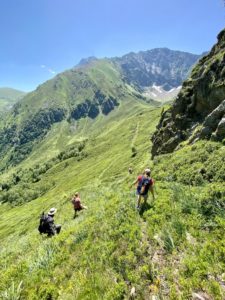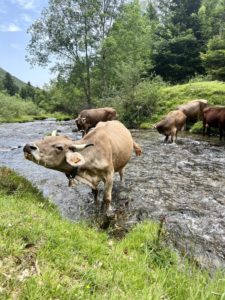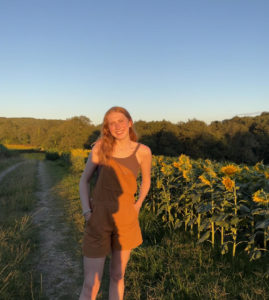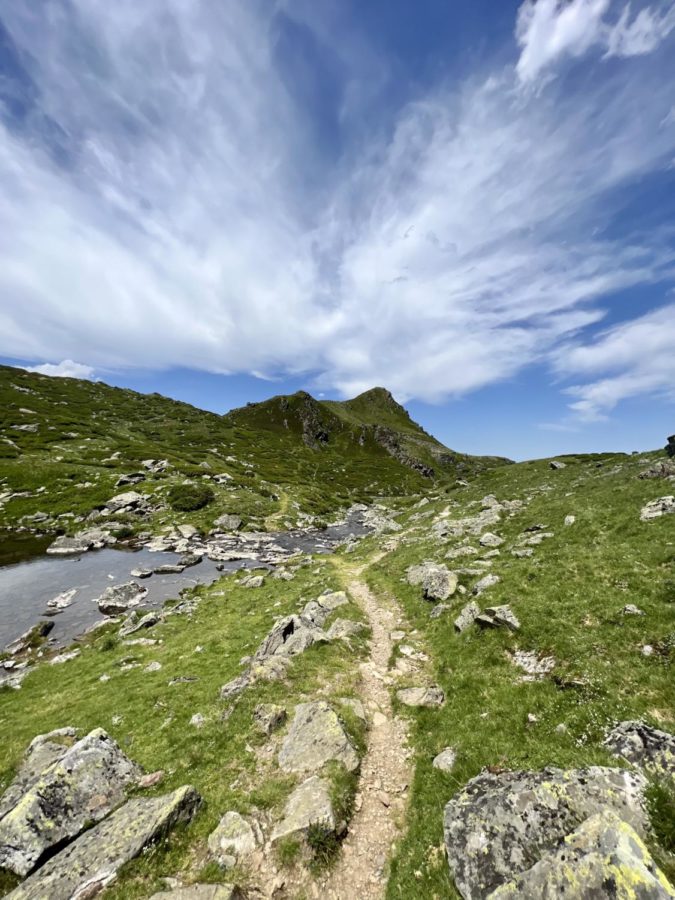A Utahn’s Escape in the Pyrenees
This summer I spent around two months in the South of France visiting family. We stayed in a small village just one hour east of the Atlantic and one hour north of the Pyrenees. Being so close to some of the most beautiful mountains in the world, we decided to plan a weekend of hiking near a small village called Lesponne.
After an hour-long drive up narrow winding roads, we arrived at a cabin where we would stay over the next few days and planned which hike to do the next morning. We decided to do a half-day hike to a lake called Lac de Peyrelade that a member of our group had done before.
The next morning, we woke up early and drove around 30 minutes up the mountains to the trailhead. The journey to the start of the hike was a completely different experience from what I have grown accustomed to in the Wasatch. The road had two lanes but was so narrow only one car could fit at a given moment. And besides one oncoming car which we had to slowly squeeze by, there was absolutely no traffic. Not too far from multiple villages and somewhat near a popular ski resort town called La Mongie, I was surprised that we were the only car going up the mountain.
After finally reaching the trailhead, we set off with our backpacks full of water, sunscreen, melon, and baguettes for a picnic at the top. The start of the hike was beautiful. The trail ran right beside a small creek and a huge field of wildflowers. As we hiked, we traversed through a pasture covered in flattened wild grass and vegetation, something starkly different to the rocky trails that we typically have here in the Wasatch. And as we made our way further up the trail, we were surrounded by trees covered in moss and by vivid green ferns covering the ground.
 However, the longer we hiked the harder it was to differentiate our path from the many meandering cow trails in the area, as most farmers in the Pyrenees let their cattle roam free. So, after about two miles of steep but beautiful trails, we ran into a sudden dead end. We could not see where the trail continued, and unfortunately the map we brought along with us didn’t provide much insight. Relying on the person who had done the hike before, we started hiking up a tiny cow trail in hope that it would rejoin the real trail. We soon ended up in the middle of dense vegetation with trees and boulders all around us, the only sense of direction coming from the glimpse of the arête above the treetops. At this point, it was far more dangerous to go back downhill, so we pushed forward, hoping we would eventually see a sign of a trail. One hour later and still without a trail, we found ourselves scrambling uphill, desperately holding on to any vegetation for balance as we traversed over sliding dirt and rocks. After aimlessly trekking through two basins, we finally saw the first signs of people and luckily only had one more mile on the real trail until we reached the lake.
However, the longer we hiked the harder it was to differentiate our path from the many meandering cow trails in the area, as most farmers in the Pyrenees let their cattle roam free. So, after about two miles of steep but beautiful trails, we ran into a sudden dead end. We could not see where the trail continued, and unfortunately the map we brought along with us didn’t provide much insight. Relying on the person who had done the hike before, we started hiking up a tiny cow trail in hope that it would rejoin the real trail. We soon ended up in the middle of dense vegetation with trees and boulders all around us, the only sense of direction coming from the glimpse of the arête above the treetops. At this point, it was far more dangerous to go back downhill, so we pushed forward, hoping we would eventually see a sign of a trail. One hour later and still without a trail, we found ourselves scrambling uphill, desperately holding on to any vegetation for balance as we traversed over sliding dirt and rocks. After aimlessly trekking through two basins, we finally saw the first signs of people and luckily only had one more mile on the real trail until we reached the lake.
While I undoubtedly got to see more of the mountain and its wildlife than I had expected, it was hard to appreciate my surroundings because I was more focused on looking out for the trail. So when we finally reached the lake, with legs caked in dirt and almost completely covered in scratches, it felt so rewarding to relax, eat, and enjoy the breathtaking views around us. I don’t think I will ever underappreciate clear trail signs and maps again.
Growing up only really hiking in Utah, and occasionally in Colorado, Wyoming, and the Pacific Northwest, hiking in the Pyrenees was surprisingly a completely different experience. We saw virtually no one on the trail, both at the beginning of the ascent before we got lost, and while at the lake. While this could be a unique circumstance, I have almost never had this experience in the Wasatch.
 While this solitude was a pleasant difference, I also started to appreciate the easy access to trails we have in the Wasatch, especially near Salt Lake City. In terms of trail quality, safety, access, and information, hiking in the Wasatch is undoubtedly a less stressful and more accessible way of hiking. However, this does come with cons, as more people typically means more pollution and decreases the chance of seeing or hearing wildlife, which to me is one of the most exciting parts of hiking.
While this solitude was a pleasant difference, I also started to appreciate the easy access to trails we have in the Wasatch, especially near Salt Lake City. In terms of trail quality, safety, access, and information, hiking in the Wasatch is undoubtedly a less stressful and more accessible way of hiking. However, this does come with cons, as more people typically means more pollution and decreases the chance of seeing or hearing wildlife, which to me is one of the most exciting parts of hiking.
On the way back down from the lake, we took a different trail that was rockier but had painted yellow lines to help us follow the path. When we finally reached the end, there were about a dozen roaming cows by our car and a horse with her foal walking on the opposite side of the field. Silently observing, I stood still, admiring for possibly the last time the beauty in this area of the Pyrenees.
While we didn’t travel far from our nearby village for this hike, it didn’t take long for us to feel like we were alone with the wildlife in the mountains. The peace and novelty that I experienced in the Pyrenees might have been my favorite part of my trip. The opportunity to be completely immersed in all the vivid noises of a forest — swaying trees, chirping birds, buzzing insects, crinkling leaves, and more — without the interruption of a single distant car engine was a welcome escape from the busy city of Salt Lake.


